Sunday, December 31, 2006
Thursday, October 20, 2005
Shoreham Airport
In October of 2005 it was reported that Tom Hanks was at Shoreham Airport to shoot scenes for 'The Da Vinci Code'

In 1930 the municipal authorities of Brighton, Hove and Worthing formed a joint committee to establish Shoreham as the municipal airport for three towns. Construction on the Terminal Building began in November 1934.
During 1935 the Croydon based company Olley Air Services Ltd., was appointed to manage the aerodrome and a service, Croydon-Shoreham-Deauville was started on the l3th July. On the 13th June 1936 this exquisite art-deco Terminal Building was officially opened by the Mayors of Brighton, Hove and Worthing. The building remains today very much in its original shape and as always, is still very much open to the public.

The opening day at Shoreham hosted an air-show and companies such as Channel Air Ferries, Railway Air Services and Jersey Airways soon started to use the airport.
Within the Terminal Building's long history, it has seen international and domestic departures and arrivals including some of the world's largest airlines. With the outbreak of war in 1939 international airline operators were removed from London (Croydon) Airport to Shoreham. These include names like Sabena, DDL, KLM and the predecessor of British Airways, Imperial Airways. Some of the destinations flown to by the above airlines included Copenhagen, Amsterdam, Malmo and Brussels.

Shoreham Airport is still at the forefront of general aviation in this country. The Terminal Building is now a Grade II listed building and is still in every day use by business, training and pleasure fliers alike including many visitors from Europe. Many of the fixtures are original including the Whispering Gallery on the first floor and the main window design above the main entrance.

In 1930 the municipal authorities of Brighton, Hove and Worthing formed a joint committee to establish Shoreham as the municipal airport for three towns. Construction on the Terminal Building began in November 1934.
During 1935 the Croydon based company Olley Air Services Ltd., was appointed to manage the aerodrome and a service, Croydon-Shoreham-Deauville was started on the l3th July. On the 13th June 1936 this exquisite art-deco Terminal Building was officially opened by the Mayors of Brighton, Hove and Worthing. The building remains today very much in its original shape and as always, is still very much open to the public.

The opening day at Shoreham hosted an air-show and companies such as Channel Air Ferries, Railway Air Services and Jersey Airways soon started to use the airport.
Within the Terminal Building's long history, it has seen international and domestic departures and arrivals including some of the world's largest airlines. With the outbreak of war in 1939 international airline operators were removed from London (Croydon) Airport to Shoreham. These include names like Sabena, DDL, KLM and the predecessor of British Airways, Imperial Airways. Some of the destinations flown to by the above airlines included Copenhagen, Amsterdam, Malmo and Brussels.

Shoreham Airport is still at the forefront of general aviation in this country. The Terminal Building is now a Grade II listed building and is still in every day use by business, training and pleasure fliers alike including many visitors from Europe. Many of the fixtures are original including the Whispering Gallery on the first floor and the main window design above the main entrance.
Tuesday, October 04, 2005
Westminster Abbey
In October of 2005 it was reported that the production team behind 'The Da Vinci Code' are allowed to film outside Westminster Abbey in London.
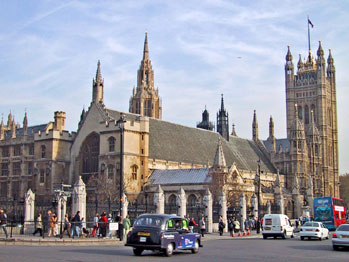
An architectural masterpiece of the 13th to 16th centuries, Westminster Abbey also presents a unique pageant of British history – the shrine of St Edward the Confessor, the tombs of kings and queens, and countless memorials to the famous and the great. It has been the setting for every Coronation since 1066 and for numerous other royal occasions. Today it is still a church dedicated to regular worship and to the celebration of great events in the life of the nation. Neither a cathedral nor a parish church, Westminster Abbey is a “Royal Peculiar” under the jurisdiction of a Dean and Chapter, subject only to the Sovereign.
Westminster Abbey, a work of architectural genius, a place of daily worship, deploying the resources of high musical expertise, a burial place of kings, statesmen, poets, scientists, warriors and musicians, is the result of a process of development across the centuries, which represents the response of a monastery and later a post-Reformation church to the stimulus and challenge of its environment.
In the 1040s King Edward (later St Edward the Confessor), last of the Anglo-Saxon kings, established his royal palace by the banks of the river Thames on land known as Thorney Island. Close by was a small Benedictine monastery founded under the patronage of King Edgar and St Dunstan around 960 AD. This monastery Edward chose to re-endow and greatly enlarge, building a large stone church in honour of St Peter the Apostle. This church became known as the “west minster” to distinguish it from St Paul’s Cathedral (the east minster) in the City of London. Unfortunately, when the new church was consecrated on 28 December 1065 the King was too ill to attend and died a few days later. His mortal remains were entombed in front of the High Altar.
The only traces of this Norman monastery are to be found in the round arches and massive supporting columns of the Undercroft in the Cloisters. This now houses the Abbey Museum but was originally part of the domestic quarters of the monks. Among the most significant ceremonies that occurred in the Norman Abbey were the coronation of William the Conqueror on Christmas day 1066, and the “translation” or moving of King Edward’s body to a new tomb a few years after his canonisation in 1161.
Edward’s Abbey survived for two centuries until the middle of the 13th century when King Henry III decided to rebuild it in the new Gothic style of architecture. It was a great age for cathedrals: in France it saw the construction of Amiens, Evreux and Chartres and in England Canterbury, Winchester and Salisbury, to mention a few. Under the decree of the King of England, Westminster Abbey was designed to be not only a great monastery and place of worship, but also a place for the coronation and burial of monarchs.
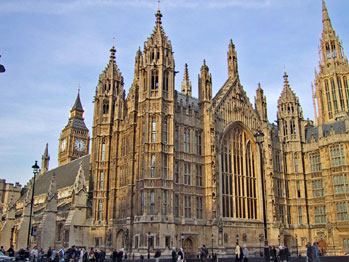
Every monarch since William the Conqueror, with the exception of Edward V and Edward VIII who were never crowned, has been crowned in the Abbey. It was natural that Henry III should wish to translate the body of the saintly Edward the Confessor into a more magnificent tomb behind the High Altar. This shrine survives and around it are buried a cluster of medieval kings and their consorts including Henry III, Edward I and Eleanor of Castile, Edward III and Philippa of Hainault, Richard II and Anne of Bohemia and Henry V. The Abbey contains some 600 monuments and wall tablets – the most important collection of monumental sculpture anywhere in the country - and over three thousand people are buried here. Notable among these is the Unknown Warrior, whose grave, close to the west door, has become a place of pilgrimage.
A remarkable new addition to the Abbey was the glorious Lady chapel built by King Henry VII, first of the Tudor monarchs, which now bears his name. The chapel has a spectacular fan-vaulted roof and the craftsmanship of Italian sculptor Torrigiano can be seen in Henry’s fine tomb. The banners of the Knights of the Order of the Bath, which surround the walls, together with the Battle of Britain window by Hugh Easton at the east end, give colour to this chapel.
Two centuries later a further addition was made to the Abbey when the western towers (left unfinished from medieval times) were completed, to a design by Nicholas Hawksmoor. Little remains of the original medieval stained glass, once one of the Abbey’s chief glories. The great west window and the rose window in the north transept date from the early 18th century but the remainder of the glass dates from the 19th century onwards.
History did not cease with the passing of the medieval monastery in 1540. Queen Elizabeth I, buried in one of the aisles of Henry VII’s chapel, refounded the Abbey in 1560 as a Collegiate Church, a Royal Peculiar exempt from the jurisdiction of bishops and with the Sovereign as its Visitor. In place of the monastic community a collegiate body of a dean and prebendaries, minor canons and a lay staff was established and charged with the task of continuing the tradition of daily worship (for which a musical foundation of choristers, singing men and organist was provided) and with the education of forty Scholars who formed the nucleus of what is now Westminster School (one of the country’s leading independent schools). In addition the Dean and Chapter were responsible for much of the civil government of Westminster, a role which was only fully relinquished in the early 20th century. Thus the Abbey was reshaped and newly patterned to discharge a distinctive yet worshipful role in a modern age.
Still today, a daily pattern of worship is offered to the Glory of God. Special services, representative of a wide spread of interest and social concern, are held regularly. In 1965-66 the Abbey celebrated its 900th anniversary, taking as its theme ‘One People’. Such a theme seemed to be fitting for a church which, through a long history of involvement with the developing life of the British people, has become known throughout the world.

An architectural masterpiece of the 13th to 16th centuries, Westminster Abbey also presents a unique pageant of British history – the shrine of St Edward the Confessor, the tombs of kings and queens, and countless memorials to the famous and the great. It has been the setting for every Coronation since 1066 and for numerous other royal occasions. Today it is still a church dedicated to regular worship and to the celebration of great events in the life of the nation. Neither a cathedral nor a parish church, Westminster Abbey is a “Royal Peculiar” under the jurisdiction of a Dean and Chapter, subject only to the Sovereign.
Westminster Abbey, a work of architectural genius, a place of daily worship, deploying the resources of high musical expertise, a burial place of kings, statesmen, poets, scientists, warriors and musicians, is the result of a process of development across the centuries, which represents the response of a monastery and later a post-Reformation church to the stimulus and challenge of its environment.
In the 1040s King Edward (later St Edward the Confessor), last of the Anglo-Saxon kings, established his royal palace by the banks of the river Thames on land known as Thorney Island. Close by was a small Benedictine monastery founded under the patronage of King Edgar and St Dunstan around 960 AD. This monastery Edward chose to re-endow and greatly enlarge, building a large stone church in honour of St Peter the Apostle. This church became known as the “west minster” to distinguish it from St Paul’s Cathedral (the east minster) in the City of London. Unfortunately, when the new church was consecrated on 28 December 1065 the King was too ill to attend and died a few days later. His mortal remains were entombed in front of the High Altar.
The only traces of this Norman monastery are to be found in the round arches and massive supporting columns of the Undercroft in the Cloisters. This now houses the Abbey Museum but was originally part of the domestic quarters of the monks. Among the most significant ceremonies that occurred in the Norman Abbey were the coronation of William the Conqueror on Christmas day 1066, and the “translation” or moving of King Edward’s body to a new tomb a few years after his canonisation in 1161.
Edward’s Abbey survived for two centuries until the middle of the 13th century when King Henry III decided to rebuild it in the new Gothic style of architecture. It was a great age for cathedrals: in France it saw the construction of Amiens, Evreux and Chartres and in England Canterbury, Winchester and Salisbury, to mention a few. Under the decree of the King of England, Westminster Abbey was designed to be not only a great monastery and place of worship, but also a place for the coronation and burial of monarchs.

Every monarch since William the Conqueror, with the exception of Edward V and Edward VIII who were never crowned, has been crowned in the Abbey. It was natural that Henry III should wish to translate the body of the saintly Edward the Confessor into a more magnificent tomb behind the High Altar. This shrine survives and around it are buried a cluster of medieval kings and their consorts including Henry III, Edward I and Eleanor of Castile, Edward III and Philippa of Hainault, Richard II and Anne of Bohemia and Henry V. The Abbey contains some 600 monuments and wall tablets – the most important collection of monumental sculpture anywhere in the country - and over three thousand people are buried here. Notable among these is the Unknown Warrior, whose grave, close to the west door, has become a place of pilgrimage.
A remarkable new addition to the Abbey was the glorious Lady chapel built by King Henry VII, first of the Tudor monarchs, which now bears his name. The chapel has a spectacular fan-vaulted roof and the craftsmanship of Italian sculptor Torrigiano can be seen in Henry’s fine tomb. The banners of the Knights of the Order of the Bath, which surround the walls, together with the Battle of Britain window by Hugh Easton at the east end, give colour to this chapel.
Two centuries later a further addition was made to the Abbey when the western towers (left unfinished from medieval times) were completed, to a design by Nicholas Hawksmoor. Little remains of the original medieval stained glass, once one of the Abbey’s chief glories. The great west window and the rose window in the north transept date from the early 18th century but the remainder of the glass dates from the 19th century onwards.
History did not cease with the passing of the medieval monastery in 1540. Queen Elizabeth I, buried in one of the aisles of Henry VII’s chapel, refounded the Abbey in 1560 as a Collegiate Church, a Royal Peculiar exempt from the jurisdiction of bishops and with the Sovereign as its Visitor. In place of the monastic community a collegiate body of a dean and prebendaries, minor canons and a lay staff was established and charged with the task of continuing the tradition of daily worship (for which a musical foundation of choristers, singing men and organist was provided) and with the education of forty Scholars who formed the nucleus of what is now Westminster School (one of the country’s leading independent schools). In addition the Dean and Chapter were responsible for much of the civil government of Westminster, a role which was only fully relinquished in the early 20th century. Thus the Abbey was reshaped and newly patterned to discharge a distinctive yet worshipful role in a modern age.
Still today, a daily pattern of worship is offered to the Glory of God. Special services, representative of a wide spread of interest and social concern, are held regularly. In 1965-66 the Abbey celebrated its 900th anniversary, taking as its theme ‘One People’. Such a theme seemed to be fitting for a church which, through a long history of involvement with the developing life of the British people, has become known throughout the world.
Tuesday, July 26, 2005
Rosslyn Chapel
In July of 2005 BBC reported that the Rosslyn Chapel has granted the production team behind 'The Da Vinci Code' to film in September of 2005.
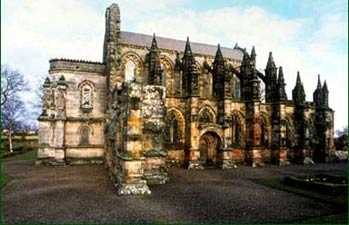
From rosslynchapel.org.uk: Rosslyn Chapel, or the Collegiate Chapel of St Matthew as it was to have been, was founded in 1446 by Sir William St Clair, third and last St Clair Prince of Orkney. It is in fact only part of the choir of what was intended to be a larger cruciform building with a tower at its centre.
More than thirty-seven collegiate churches were built in Scotland between the reigns of James I and James IV (1406-1513). They were secular foundations intended to spread intellectual and spiritual knowledge, and the extravagance of their construction depended on the wealth of their founder.
After Sir William died in 1484, he was buried in the unfinished Chapel and the larger building he had planned was never completed. But the foundations of the nave are said to have been excavated in the nineteenth century and found to extend ninety-one feet beyond the Chapel's original west door, under the existing baptistry and churchyard.
What was built however is extraordinary enough, 'This building, I believe, may be pronounced unique, and I am confident it will be found curious, elaborate and singularly interesting, impossible to designate by any given or familiar term' wrote Britton on his Architectural Antiquities of Britain (1812), adding somewhat despairingly that its 'variety and eccentricity are not to be defined by any words of common acceptation.'.
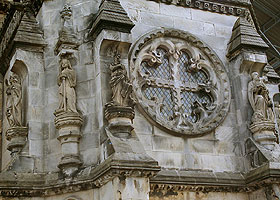 The principal authority on the history of the Chapel and the St Clair family is Father Richard Augustine Hay, Canon of St Genevieve in Paris and Prior of St Piermont. He examined historical records and charters of the St Clairs and completed a three volume study in 1700, parts of which were published in 1835 as A geneologie of the Sainteclaires of Rosslyn. His research was timely, since the original documents subsequently disappeared.
The principal authority on the history of the Chapel and the St Clair family is Father Richard Augustine Hay, Canon of St Genevieve in Paris and Prior of St Piermont. He examined historical records and charters of the St Clairs and completed a three volume study in 1700, parts of which were published in 1835 as A geneologie of the Sainteclaires of Rosslyn. His research was timely, since the original documents subsequently disappeared.
Of the founder Father Hay said this: 'Prince William, his age creeping on him, came to consider how he had spent his times past, and how he was to spend his remaining days. Therefore, to the end, that he might not seem altogether unthankful to God for the benefices he received from Him, it came into his mind to build a house for God's service, of most curious work, the which that it might be done with greater glory and splendour he caused artificers to be brought from other regions and foreign kingdoms and caused daily to be abundance of all kinds of workmen present as masons, carpenters, smiths, barrowmen and quarriers... the foundation of this work he caused to be lain in the year of our Lord 1446, and to the end, the work might be more rare, first he caused draughts [plans] to be drawn upon eastland boards [imported Baltic timber], and he made the carpenters carve them according to the draughts thereon and he gave them to for patterns to the masons, that they might cut the like in stone and because he thought the masons had not a convenient place to lodge in...he made them build the town of Rolsine that is now extant and gave everyone a house and lands. He rewarded the masons according to their degree, as to the Master Mason, he gave nearly £40 yearly, and to everyone of the rest, £10...
Sir William's son and successor to the Barony of Rosslyn, Sir Oliver St Clair, roofed the choir with its stone vault but did no more to fulfil his father's original design.
The Chapel was generously endowed by the founder, with provision for a provost, six prebendaries and two choristers, and in 1523 by his grandson, also Sir William, with land for dwelling houses and gardens. On February 26th ,1571, however, just forty-eight years after his last endowment, there is a record of the provost and prebendaries resigning because of the endowments being taken by 'force and violence' into secular hands as the effects of the Reformation took hold.
In March 1997, a free-standing steel structure was erected to cover the Chapel. It will enable the stone fabric of the roof vaults to dry outwards, away from the carved interior surfaces. In due course the bituminous felt, asphalt and concrete coverings of the stone roof vaults will be removed to assist this process. Stone and mortar repairs to the external walls, pinnacles, and buttresses, renewal of the rainwater disposal arrangements, repairs to the stained glass, and appropriate repair and conservation of the interior are all required. The coverings over the stone vaulted roofs will be renewed in lead and ways of removing the cementitious slurry are being investigated, in order that this magnificent building can be preserved for future generations to use and admire.
H.R.H. Prince Charles paid a visit to Rosslyn Chapel
Thursday 2nd April 1998
We were honoured to have The Prince of Wales as a visitor to Rosslyn on the 2nd of April. The Prince was introduced to the Earl and Countess of Rosslyn, their two eldest children and members of staff along with those involved as Design Team members for the current phase.
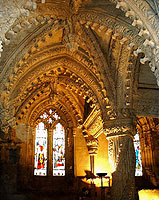
The Prince toured the Chapel and took the opportunity for a unique view from the 21 foot high walkway. He then toured the new Visitor Centre and to mark his visit, unveiled a plaque and signed the visitors book. The Prince's visit follows a long tradition which has seen George V and Queen Mary visit in 1931 along with Prince Albert (later King George VI) and the Princess Elizabeth. The Queen and Prince Philip visited in 1961 and Princess Margaret in 1988. The Prince of Wales has a keen interest in Architecture and history and said that he has long held a desire to visit Rosslyn.
The year 2000 saw the Trust embark on a second phase of work. Funded jointly by The National Heritage Lottery Fund, The Eastern Scotland European Partnership, Historic Scotland and the Rosslyn Chapel Trust, this phase has a number of elements. Essential stabilisation works to the east boundary walls will protect the Chapel. A new roof of Caithness slate has been placed over the existing Crypt roof, and the Priest's Cell and two more modern buildings beside the Crypt have been made functional. The stairs to the Crypt have been repaired and the access to the Crypt is now both safer and more of an experience. Work has also been carried out to improve the electrical services in the Chapel, repairs to the wooden screen at the west end, and our interpretation of Rosslyn's story.

From rosslynchapel.org.uk: Rosslyn Chapel, or the Collegiate Chapel of St Matthew as it was to have been, was founded in 1446 by Sir William St Clair, third and last St Clair Prince of Orkney. It is in fact only part of the choir of what was intended to be a larger cruciform building with a tower at its centre.
More than thirty-seven collegiate churches were built in Scotland between the reigns of James I and James IV (1406-1513). They were secular foundations intended to spread intellectual and spiritual knowledge, and the extravagance of their construction depended on the wealth of their founder.
After Sir William died in 1484, he was buried in the unfinished Chapel and the larger building he had planned was never completed. But the foundations of the nave are said to have been excavated in the nineteenth century and found to extend ninety-one feet beyond the Chapel's original west door, under the existing baptistry and churchyard.
What was built however is extraordinary enough, 'This building, I believe, may be pronounced unique, and I am confident it will be found curious, elaborate and singularly interesting, impossible to designate by any given or familiar term' wrote Britton on his Architectural Antiquities of Britain (1812), adding somewhat despairingly that its 'variety and eccentricity are not to be defined by any words of common acceptation.'.
 The principal authority on the history of the Chapel and the St Clair family is Father Richard Augustine Hay, Canon of St Genevieve in Paris and Prior of St Piermont. He examined historical records and charters of the St Clairs and completed a three volume study in 1700, parts of which were published in 1835 as A geneologie of the Sainteclaires of Rosslyn. His research was timely, since the original documents subsequently disappeared.
The principal authority on the history of the Chapel and the St Clair family is Father Richard Augustine Hay, Canon of St Genevieve in Paris and Prior of St Piermont. He examined historical records and charters of the St Clairs and completed a three volume study in 1700, parts of which were published in 1835 as A geneologie of the Sainteclaires of Rosslyn. His research was timely, since the original documents subsequently disappeared.Of the founder Father Hay said this: 'Prince William, his age creeping on him, came to consider how he had spent his times past, and how he was to spend his remaining days. Therefore, to the end, that he might not seem altogether unthankful to God for the benefices he received from Him, it came into his mind to build a house for God's service, of most curious work, the which that it might be done with greater glory and splendour he caused artificers to be brought from other regions and foreign kingdoms and caused daily to be abundance of all kinds of workmen present as masons, carpenters, smiths, barrowmen and quarriers... the foundation of this work he caused to be lain in the year of our Lord 1446, and to the end, the work might be more rare, first he caused draughts [plans] to be drawn upon eastland boards [imported Baltic timber], and he made the carpenters carve them according to the draughts thereon and he gave them to for patterns to the masons, that they might cut the like in stone and because he thought the masons had not a convenient place to lodge in...he made them build the town of Rolsine that is now extant and gave everyone a house and lands. He rewarded the masons according to their degree, as to the Master Mason, he gave nearly £40 yearly, and to everyone of the rest, £10...
Sir William's son and successor to the Barony of Rosslyn, Sir Oliver St Clair, roofed the choir with its stone vault but did no more to fulfil his father's original design.
The Chapel was generously endowed by the founder, with provision for a provost, six prebendaries and two choristers, and in 1523 by his grandson, also Sir William, with land for dwelling houses and gardens. On February 26th ,1571, however, just forty-eight years after his last endowment, there is a record of the provost and prebendaries resigning because of the endowments being taken by 'force and violence' into secular hands as the effects of the Reformation took hold.
In March 1997, a free-standing steel structure was erected to cover the Chapel. It will enable the stone fabric of the roof vaults to dry outwards, away from the carved interior surfaces. In due course the bituminous felt, asphalt and concrete coverings of the stone roof vaults will be removed to assist this process. Stone and mortar repairs to the external walls, pinnacles, and buttresses, renewal of the rainwater disposal arrangements, repairs to the stained glass, and appropriate repair and conservation of the interior are all required. The coverings over the stone vaulted roofs will be renewed in lead and ways of removing the cementitious slurry are being investigated, in order that this magnificent building can be preserved for future generations to use and admire.
H.R.H. Prince Charles paid a visit to Rosslyn Chapel
Thursday 2nd April 1998
We were honoured to have The Prince of Wales as a visitor to Rosslyn on the 2nd of April. The Prince was introduced to the Earl and Countess of Rosslyn, their two eldest children and members of staff along with those involved as Design Team members for the current phase.

The Prince toured the Chapel and took the opportunity for a unique view from the 21 foot high walkway. He then toured the new Visitor Centre and to mark his visit, unveiled a plaque and signed the visitors book. The Prince's visit follows a long tradition which has seen George V and Queen Mary visit in 1931 along with Prince Albert (later King George VI) and the Princess Elizabeth. The Queen and Prince Philip visited in 1961 and Princess Margaret in 1988. The Prince of Wales has a keen interest in Architecture and history and said that he has long held a desire to visit Rosslyn.
The year 2000 saw the Trust embark on a second phase of work. Funded jointly by The National Heritage Lottery Fund, The Eastern Scotland European Partnership, Historic Scotland and the Rosslyn Chapel Trust, this phase has a number of elements. Essential stabilisation works to the east boundary walls will protect the Chapel. A new roof of Caithness slate has been placed over the existing Crypt roof, and the Priest's Cell and two more modern buildings beside the Crypt have been made functional. The stairs to the Crypt have been repaired and the access to the Crypt is now both safer and more of an experience. Work has also been carried out to improve the electrical services in the Chapel, repairs to the wooden screen at the west end, and our interpretation of Rosslyn's story.
Sunday, May 29, 2005
Louvre Museum

In May of 2005 ITV reported that The Lourve has granted the production team behind 'The Da Vinci Code' to film at the historic museum.
 The Louvre was not in any way originally intended to become a museum. The "salle des antiques" which Henri VI set up on the ground floor of the Grande Galerie was not accessible to the general public, nor was the king's cabinet of drawings, created in 1671, or the king's cabinet of paintings, to which access was reserved for a privileged few.
The Louvre was not in any way originally intended to become a museum. The "salle des antiques" which Henri VI set up on the ground floor of the Grande Galerie was not accessible to the general public, nor was the king's cabinet of drawings, created in 1671, or the king's cabinet of paintings, to which access was reserved for a privileged few.From the date when, under Louis XIV, most of its occupants left the Louvre, its vocation as a "palace of the arts" appeared a quite natural progression in the eyes of the resident artists and the academies. The idea of a Palace of the Muses or "Muséum", where one could view the royal collections, was born in 1747. The museum concept, which was quite new at the time, ran along the same lines as the Encyclopedia and the philosophy of the Enlightenment. From 1779, purchases and museographical projects demonstrate the imminence of its realisation.
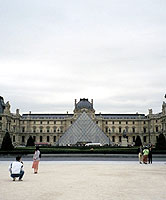 The Second Republic and the Second Empire pursued the same policy. The museum, more of which was opened to the public, continued to extend its collections and to add new areas, such as those of the Etruscans, Archaic Greece and the Ancient Orient.
The Second Republic and the Second Empire pursued the same policy. The museum, more of which was opened to the public, continued to extend its collections and to add new areas, such as those of the Etruscans, Archaic Greece and the Ancient Orient.Napoleon III commissioned the architect Visconti to complete the Palace. Hector Lefuel, who succeeded him on the site, led the work and imposed his ideas in an excessive and self-opinionated manner. The section which separated the two palaces was torn down, symmetrical blocks enclosed the new cour Napoléon, the façades were covered with a riot of decoration and the North wing closed off the whole unit. The Nouveau Louvre, which was inaugurated in 1857, finally completed the "Grand Dessein" or Grand Design. Transformations which were completed in 1869 changed the appearance of the South-West wing.
The benefit of these efforts was enjoyed for only two years, since the palais des Tuileries was destroyed by fire in 1871.
 In 1882, after twelve years of projects and of beating about the bush, the demolition of the Tuileries ruins put an end to the building's palatial function. But Lefuel rebuilt the "Pavillon de Flore" and "Pavillon de Marsan" blocks and the North wings, which housed the Finance Ministry. The history of the Louvre Palace henceforth became linked to that of the Museum.
In 1882, after twelve years of projects and of beating about the bush, the demolition of the Tuileries ruins put an end to the building's palatial function. But Lefuel rebuilt the "Pavillon de Flore" and "Pavillon de Marsan" blocks and the North wings, which housed the Finance Ministry. The history of the Louvre Palace henceforth became linked to that of the Museum.Once again, its appearance was altered with new decorations, for example the great staircase (1934), which is now dominated by the Winged Victory of Samothrace, the antichamber of Henri II, the ceiling of which is adorned with a composition by Georges Braque (1953). As a national museum, the Louvre has continued through the XXth century to enrich its collections and to display them to advantage.
But by the seventies, the available space was not longer able to cope with the growing collections and with the public popularity of the museum. A radical solution was needed. Thus most of the post 1848 work was transferred in 1986 to the musée d'Orsay, which was created on the opposite bank of the Seine, and renovation work began on the Louvre itself.
Everything has been designed in such a way as to allow as many members of the public as possible to gain access to the museum. A welcoming reception and a pleasant visit have been prime factors. In the Auditorium, the public are offered concerts, lectures and films.
By rethinking its function as a museum, the Louvre Palace has rediscovered a rich and animated life at the heart of the city.
The "Grand Louvre" constituted the realisation of an earlier project, which involved devoting the entire Palace to the function of a museum, whilst modernising and improving the presentation of the collections.
Covering an area of some 40 hectares right in the heart of Paris, on the right bank of the Seine, the Louvre offers almost 60,000 m² of exhibition rooms dedicated to preserving items representing 11 millennia of civilisation and culture. The "Grand Louvre" is also a cultural unit which has a didactic role towards the public, a role which it fulfils through lectures, audiovisual and interactive productions and very many printed publications which are available in the exhibition rooms or at the bookshop under the pyramid.
The Lincoln Cathedral
The Lincoln Church will double for London's Westminster Abbey ITV reported in May of 2005.
Construction
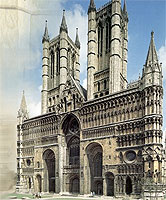 Lincoln CathedralWilliam the Conqueror ordered the first cathedral to be built in Lincoln, in 1072; before that, St. Mary's church in Lincoln was a mother church but not a cathedral. Bishop Remigius built the first Lincoln Cathedral on the present site, finishing it in 1092 and then dying two days before it was to be consecrated on May 9 of that year. About fifty years later, most of that building was destroyed in a fire. Bishop Alexander rebuilt and expanded the cathedral, but it was destroyed by an earthquake about forty years later, in 1185, while there was no bishop. The central tower rises to 271 feet and remains the tallest cathedral tower in Europe today without a spire. There was a lead-encased wooden spire that rose 525 feet, that collapsed in 1549 thanks to weather; it was the first building to ever exceed the height of the Great Pyramid of Giza, thereby becoming the world's tallest structure, and remaining that for more than two centuries, until the collapse of the spire. Up to that point in time, the next point on the earths surface at the same height, looking eastwards, was the Ural Mountains in Russia.
Lincoln CathedralWilliam the Conqueror ordered the first cathedral to be built in Lincoln, in 1072; before that, St. Mary's church in Lincoln was a mother church but not a cathedral. Bishop Remigius built the first Lincoln Cathedral on the present site, finishing it in 1092 and then dying two days before it was to be consecrated on May 9 of that year. About fifty years later, most of that building was destroyed in a fire. Bishop Alexander rebuilt and expanded the cathedral, but it was destroyed by an earthquake about forty years later, in 1185, while there was no bishop. The central tower rises to 271 feet and remains the tallest cathedral tower in Europe today without a spire. There was a lead-encased wooden spire that rose 525 feet, that collapsed in 1549 thanks to weather; it was the first building to ever exceed the height of the Great Pyramid of Giza, thereby becoming the world's tallest structure, and remaining that for more than two centuries, until the collapse of the spire. Up to that point in time, the next point on the earths surface at the same height, looking eastwards, was the Ural Mountains in Russia.
History
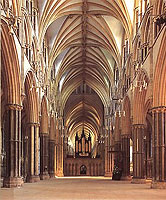 Lincoln Cathedral looking inside the central towerKing Henry II of England approved the election of Hugh of Avalon, a Carthusian monk and later canonized a saint, as Bishop of Lincoln in 1186, and St. Hugh died in 1200, before his plan for the rebuilding was completed. The western end of the cathedral was always where it is now, but the eastern end (east of the original, now "great" transept) was moved eastward each time the cathedral was enlarged: The eastern wall of the Norman building (1073) was in the middle of what is now St. Hugh's Choir. The eastern end of the Early English building (1186) was in what is now the Angel Choir behind the High Altar. The existing structure was finished by about 1280, but repairs and remodeling have continued, and there have been repeated problems with the spires (removed in 1807) and towers, which were sometimes thought to be in danger of collapsing, this was despite attempts to shore up the towers by digging underneath them to increase support, an early attempt of what is a common engineering project today on such building as the Leaning Tower of Pisa. Among the persons interred in Lincoln Cathedral are:
Lincoln Cathedral looking inside the central towerKing Henry II of England approved the election of Hugh of Avalon, a Carthusian monk and later canonized a saint, as Bishop of Lincoln in 1186, and St. Hugh died in 1200, before his plan for the rebuilding was completed. The western end of the cathedral was always where it is now, but the eastern end (east of the original, now "great" transept) was moved eastward each time the cathedral was enlarged: The eastern wall of the Norman building (1073) was in the middle of what is now St. Hugh's Choir. The eastern end of the Early English building (1186) was in what is now the Angel Choir behind the High Altar. The existing structure was finished by about 1280, but repairs and remodeling have continued, and there have been repeated problems with the spires (removed in 1807) and towers, which were sometimes thought to be in danger of collapsing, this was despite attempts to shore up the towers by digging underneath them to increase support, an early attempt of what is a common engineering project today on such building as the Leaning Tower of Pisa. Among the persons interred in Lincoln Cathedral are:
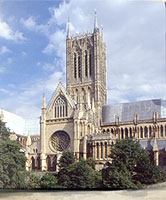 Lincoln Cathedral and its bishops have also had a leading role in the history of England. Most importantly is the Magna Carta which was signed by the Bishop of Lincoln amongst others, and what is one of only two copies resides in the cathedral's library although it is lent out to American museums to raise funds, a problem the diocese has suffered ever since the reformation. With more monasteries than everywhere else in England put together in Lincolnshire alone and a vast number in other lands controlled by the diocese the reformation cut off the main source of income to the Cathedral leaving the massive structure under the care of an organisation that can barely support it.
Lincoln Cathedral and its bishops have also had a leading role in the history of England. Most importantly is the Magna Carta which was signed by the Bishop of Lincoln amongst others, and what is one of only two copies resides in the cathedral's library although it is lent out to American museums to raise funds, a problem the diocese has suffered ever since the reformation. With more monasteries than everywhere else in England put together in Lincolnshire alone and a vast number in other lands controlled by the diocese the reformation cut off the main source of income to the Cathedral leaving the massive structure under the care of an organisation that can barely support it.
The Lincoln Imp
One of the stone gargoyles within the Cathedral is the Lincoln Imp, of which there are several variations of the legend surrounding the figure. The general gist of the story is that the Imp was sent by Satan to cause mayhem in the cathedral, but was challenged and ordered to stop by an Angel, in the Angel Choir. The Imp laughed, sat on a stone pillar and threw rocks the the Angel, so the Angel turned the Imp to stone, and he is there today, sitting on the same stone pillar in the Angel Choir.
Today
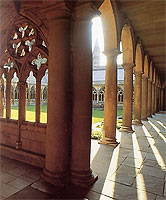 A close up of some of the severely eroded stonework on Lincoln CathedralOver £1 million a year is spent on keeping the cathedral in shape, the most recent project completed has been the restoration of the West Front in 2000. About 10 years ago it was discovered that the Flying Buttresses on the east end were no longer connected to the adjoining stonework, and hasty repairs had to be made.
A close up of some of the severely eroded stonework on Lincoln CathedralOver £1 million a year is spent on keeping the cathedral in shape, the most recent project completed has been the restoration of the West Front in 2000. About 10 years ago it was discovered that the Flying Buttresses on the east end were no longer connected to the adjoining stonework, and hasty repairs had to be made.
The problems arise because the building techniques used were groundbreaking at the time, and the builders were literally making it up as they went along. It was not unknown for newly built parts to collapse shortly afterwards, as they learned the techniques and methods needed to build in this style. Remember, up to this point, there were only Norman churches, which were short, dark, and with thick walls and small windows. The introduction of Gothic style made churches bright and spacious, but they were writing the rule book at the same time, and it was literally trial and error.
Worryingly though, parts of the ceiling of the nave have started to fall requiring green netting to be slung under it to catch any pieces as the only alternative to shutting the cathedral. The outside has fared little better as tourists have had to dodge pieces of falling masonry creating the need for urgent repairs of some decayed stonework.
The central window in the quire, is in danger of falling out and the supporting stonework around it held up only by connecting metal struts fixed diagonally to the ground. A similar fate is threatened for the Dean's Eye window in the north transept, dating from 1220, still with much of its original mediaeval glass depicting the Last Judgement, but patched over the years with a metal frame to stop it also falling out.
Despite the problems Lincoln Cathedral remains much loved and is visited by over 250,000 tourists a year. The peak of its season are the Lincoln Christmas Market and a massive annual production of Handels 'the Messiah'
Construction
 Lincoln CathedralWilliam the Conqueror ordered the first cathedral to be built in Lincoln, in 1072; before that, St. Mary's church in Lincoln was a mother church but not a cathedral. Bishop Remigius built the first Lincoln Cathedral on the present site, finishing it in 1092 and then dying two days before it was to be consecrated on May 9 of that year. About fifty years later, most of that building was destroyed in a fire. Bishop Alexander rebuilt and expanded the cathedral, but it was destroyed by an earthquake about forty years later, in 1185, while there was no bishop. The central tower rises to 271 feet and remains the tallest cathedral tower in Europe today without a spire. There was a lead-encased wooden spire that rose 525 feet, that collapsed in 1549 thanks to weather; it was the first building to ever exceed the height of the Great Pyramid of Giza, thereby becoming the world's tallest structure, and remaining that for more than two centuries, until the collapse of the spire. Up to that point in time, the next point on the earths surface at the same height, looking eastwards, was the Ural Mountains in Russia.
Lincoln CathedralWilliam the Conqueror ordered the first cathedral to be built in Lincoln, in 1072; before that, St. Mary's church in Lincoln was a mother church but not a cathedral. Bishop Remigius built the first Lincoln Cathedral on the present site, finishing it in 1092 and then dying two days before it was to be consecrated on May 9 of that year. About fifty years later, most of that building was destroyed in a fire. Bishop Alexander rebuilt and expanded the cathedral, but it was destroyed by an earthquake about forty years later, in 1185, while there was no bishop. The central tower rises to 271 feet and remains the tallest cathedral tower in Europe today without a spire. There was a lead-encased wooden spire that rose 525 feet, that collapsed in 1549 thanks to weather; it was the first building to ever exceed the height of the Great Pyramid of Giza, thereby becoming the world's tallest structure, and remaining that for more than two centuries, until the collapse of the spire. Up to that point in time, the next point on the earths surface at the same height, looking eastwards, was the Ural Mountains in Russia.History
 Lincoln Cathedral looking inside the central towerKing Henry II of England approved the election of Hugh of Avalon, a Carthusian monk and later canonized a saint, as Bishop of Lincoln in 1186, and St. Hugh died in 1200, before his plan for the rebuilding was completed. The western end of the cathedral was always where it is now, but the eastern end (east of the original, now "great" transept) was moved eastward each time the cathedral was enlarged: The eastern wall of the Norman building (1073) was in the middle of what is now St. Hugh's Choir. The eastern end of the Early English building (1186) was in what is now the Angel Choir behind the High Altar. The existing structure was finished by about 1280, but repairs and remodeling have continued, and there have been repeated problems with the spires (removed in 1807) and towers, which were sometimes thought to be in danger of collapsing, this was despite attempts to shore up the towers by digging underneath them to increase support, an early attempt of what is a common engineering project today on such building as the Leaning Tower of Pisa. Among the persons interred in Lincoln Cathedral are:
Lincoln Cathedral looking inside the central towerKing Henry II of England approved the election of Hugh of Avalon, a Carthusian monk and later canonized a saint, as Bishop of Lincoln in 1186, and St. Hugh died in 1200, before his plan for the rebuilding was completed. The western end of the cathedral was always where it is now, but the eastern end (east of the original, now "great" transept) was moved eastward each time the cathedral was enlarged: The eastern wall of the Norman building (1073) was in the middle of what is now St. Hugh's Choir. The eastern end of the Early English building (1186) was in what is now the Angel Choir behind the High Altar. The existing structure was finished by about 1280, but repairs and remodeling have continued, and there have been repeated problems with the spires (removed in 1807) and towers, which were sometimes thought to be in danger of collapsing, this was despite attempts to shore up the towers by digging underneath them to increase support, an early attempt of what is a common engineering project today on such building as the Leaning Tower of Pisa. Among the persons interred in Lincoln Cathedral are:- St. Hugh of Avalon, in the Angel Choir
- Richard Fleming, (died 1431), Bishop of Lincoln, in the first cadaver tomb ever, in a chantry on the north wall. His moldering corpse is realistically depicted below his effigy.
- Katherine Swynford and her daughter Joan Beaufort, in a chantry on the south side of the sanctuary
 Lincoln Cathedral and its bishops have also had a leading role in the history of England. Most importantly is the Magna Carta which was signed by the Bishop of Lincoln amongst others, and what is one of only two copies resides in the cathedral's library although it is lent out to American museums to raise funds, a problem the diocese has suffered ever since the reformation. With more monasteries than everywhere else in England put together in Lincolnshire alone and a vast number in other lands controlled by the diocese the reformation cut off the main source of income to the Cathedral leaving the massive structure under the care of an organisation that can barely support it.
Lincoln Cathedral and its bishops have also had a leading role in the history of England. Most importantly is the Magna Carta which was signed by the Bishop of Lincoln amongst others, and what is one of only two copies resides in the cathedral's library although it is lent out to American museums to raise funds, a problem the diocese has suffered ever since the reformation. With more monasteries than everywhere else in England put together in Lincolnshire alone and a vast number in other lands controlled by the diocese the reformation cut off the main source of income to the Cathedral leaving the massive structure under the care of an organisation that can barely support it.The Lincoln Imp
One of the stone gargoyles within the Cathedral is the Lincoln Imp, of which there are several variations of the legend surrounding the figure. The general gist of the story is that the Imp was sent by Satan to cause mayhem in the cathedral, but was challenged and ordered to stop by an Angel, in the Angel Choir. The Imp laughed, sat on a stone pillar and threw rocks the the Angel, so the Angel turned the Imp to stone, and he is there today, sitting on the same stone pillar in the Angel Choir.
Today
 A close up of some of the severely eroded stonework on Lincoln CathedralOver £1 million a year is spent on keeping the cathedral in shape, the most recent project completed has been the restoration of the West Front in 2000. About 10 years ago it was discovered that the Flying Buttresses on the east end were no longer connected to the adjoining stonework, and hasty repairs had to be made.
A close up of some of the severely eroded stonework on Lincoln CathedralOver £1 million a year is spent on keeping the cathedral in shape, the most recent project completed has been the restoration of the West Front in 2000. About 10 years ago it was discovered that the Flying Buttresses on the east end were no longer connected to the adjoining stonework, and hasty repairs had to be made.The problems arise because the building techniques used were groundbreaking at the time, and the builders were literally making it up as they went along. It was not unknown for newly built parts to collapse shortly afterwards, as they learned the techniques and methods needed to build in this style. Remember, up to this point, there were only Norman churches, which were short, dark, and with thick walls and small windows. The introduction of Gothic style made churches bright and spacious, but they were writing the rule book at the same time, and it was literally trial and error.
Worryingly though, parts of the ceiling of the nave have started to fall requiring green netting to be slung under it to catch any pieces as the only alternative to shutting the cathedral. The outside has fared little better as tourists have had to dodge pieces of falling masonry creating the need for urgent repairs of some decayed stonework.
The central window in the quire, is in danger of falling out and the supporting stonework around it held up only by connecting metal struts fixed diagonally to the ground. A similar fate is threatened for the Dean's Eye window in the north transept, dating from 1220, still with much of its original mediaeval glass depicting the Last Judgement, but patched over the years with a metal frame to stop it also falling out.
Despite the problems Lincoln Cathedral remains much loved and is visited by over 250,000 tourists a year. The peak of its season are the Lincoln Christmas Market and a massive annual production of Handels 'the Messiah'